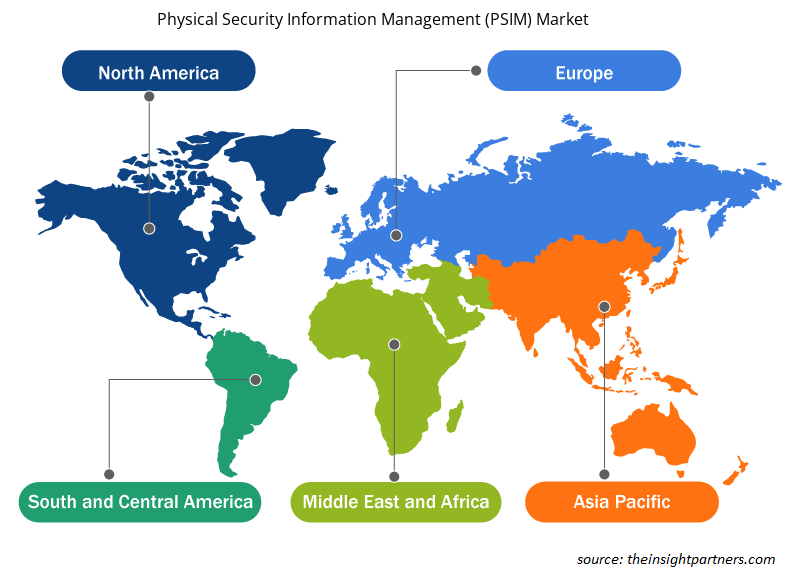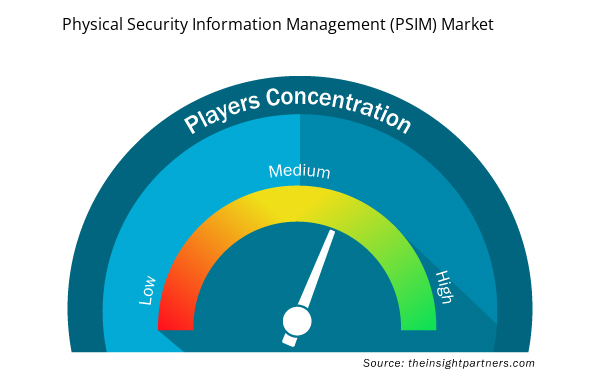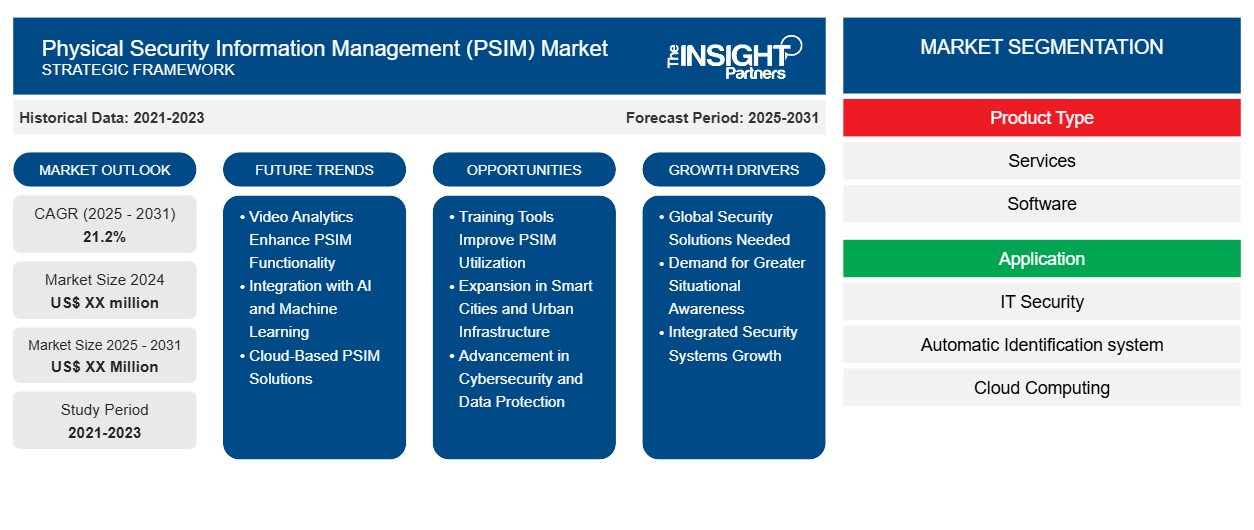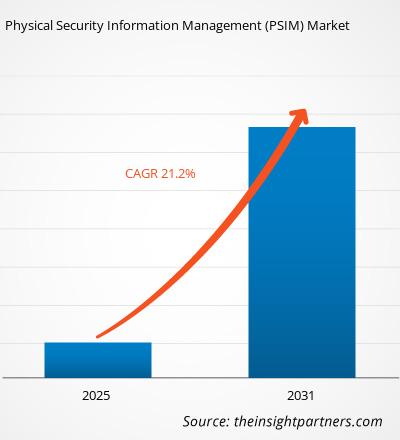Der Markt für Physical Security Information Management (PSIM) wird voraussichtlich von 2023 bis 2031 eine durchschnittliche jährliche Wachstumsrate (CAGR) von 21,2 % verzeichnen, wobei die Marktgröße von XX Millionen US-Dollar im Jahr 2023 auf XX Millionen US-Dollar im Jahr 2031 wachsen wird.
Der Marktbericht zum Physical Security Information Management (PSIM) umfasst Analysen basierend auf dem Produkttyp. Der Markt ist nach Produkttyp in Dienste und Software unterteilt. Der Bericht bietet auch Analysen nach Anwendung (IT-Sicherheit, automatische Identifikationssysteme, Cloud Computing, Rechenzentren und andere). Die globale Analyse ist weiter auf regionaler Ebene und in den wichtigsten Ländern aufgeschlüsselt.
Zweck des Berichts
Der Bericht „Physical Security Information Management (PSIM) Market“ von The Insight Partners zielt darauf ab, die aktuelle Situation und das zukünftige Wachstum sowie die wichtigsten treibenden Faktoren, Herausforderungen und Chancen zu beschreiben. Dies wird verschiedenen Geschäftspartnern Einblicke geben, wie zum Beispiel:
- Technologieanbieter/-hersteller: Um die sich entwickelnde Marktdynamik zu verstehen und die potenziellen Wachstumschancen zu kennen, damit sie fundierte strategische Entscheidungen treffen können.
- Investoren: Durchführung einer umfassenden Trendanalyse hinsichtlich der Marktwachstumsrate, der finanziellen Marktprognosen und der Chancen entlang der Wertschöpfungskette.
- Regulierungsbehörden: Zur Regulierung von Richtlinien und Überwachungsaktivitäten auf dem Markt mit dem Ziel, Missbrauch zu minimieren, das Vertrauen der Anleger zu bewahren und die Integrität und Stabilität des Marktes aufrechtzuerhalten.
Marktsegmentierung für physisches Sicherheitsinformationsmanagement (PSIM)
Produkttyp
- Dienstleistungen
- Software
Anwendung
- IT-Sicherheit
- Automatisches Identifikationssystem
- Cloud Computing
- Rechenzentrum
- Sonstiges
Passen Sie diesen Bericht Ihren Anforderungen an
Sie erhalten kostenlose Anpassungen an jedem Bericht, einschließlich Teilen dieses Berichts oder einer Analyse auf Länderebene, eines Excel-Datenpakets sowie tolle Angebote und Rabatte für Start-ups und Universitäten.
- Holen Sie sich die wichtigsten Markttrends aus diesem Bericht.Dieses KOSTENLOSE Beispiel umfasst eine Datenanalyse von Markttrends bis hin zu Schätzungen und Prognosen.
Wachstumstreiber auf dem Markt für Physical Security Information Management (PSIM)
- Globale Sicherheitslösungen erforderlich: Ob Terrorismus, Vandalismus oder Cyber-Angriffe – weltweit sind fortschrittlichere Sicherheitslösungen erforderlich. Unternehmen müssen ihre Ressourcen und ihr geistiges Eigentum schützen. Es werden immer mehr Sicherheitssysteme installiert, beispielsweise Kameras, Zugangskontrollen und andere Geräte.
- Forderung nach besserer Situationswahrnehmung: Unternehmen in einem komplexen Sicherheitsumfeld verlangen von ihren Sicherheitssystemen eine bessere Situationswahrnehmung, um Sicherheitsvorfälle proaktiver und effizienter bewältigen zu können. PSIM-Lösungen helfen dabei, indem sie Sicherheitsdaten aus mehreren isolierten Standalone-Systemen zu einer einheitlichen globalen Ansicht der Sicherheitsabläufe zusammenführen.
- Wachstum integrierter Sicherheitssysteme: Sie drängen Organisationen auch dazu, integrierte Sicherheitslösungen einzuführen, die eine reibungslose Koordination zwischen verschiedenen Sicherheitssystemen ermöglichen, und davon profitiert auch der Sektor des Sicherheitsinformationsmanagements (SIM). PSIM ermöglicht es Organisationen, verschiedene Sicherheitstechnologien wie Videoüberwachung, Zugangskontrolle, IP-basierte Alarmsysteme, Mobiltelefonübertragung usw. auf einer einzigen Plattform zu integrieren, um eine verbesserte Betriebseffizienz, kürzere Reaktionszeiten und weniger Sicherheitslücken zu erreichen. Angesichts der wachsenden Nachfrage nach Konsolidierung von Sicherheitsabläufen und verbesserter Kontrolle zur Bewältigung von Vorfällen wird der Markt für integrierte PSIM-Lösungen in den kommenden Jahren voraussichtlich stark wachsen.
Zukünftige Trends auf dem Markt für Physical Security Information Management (PSIM)
- Videoanalyse verbessert PSIM-Funktionalität: Ein wichtiger Trend ist die Verwendung von Videoanalyse in PSIMs. Die Hinzufügung von Technologien wie beispielsweise Gewalterkennungsalgorithmen verbessert die Funktionalität eines Systems und verbessert die Reaktionsfähigkeit von Organisationen. Videoanalysetools können auch ungewöhnliche Bewegungen und Aktionen identifizieren und verdächtiges Verhalten in einer Menschenmenge erkennen, während die Analyse von Menschenmengen Systemen dabei helfen kann, Einbrüche, Ausgänge und Ausgänge in der Nähe von Zugangskontrollen zu überwachen. Dies wird auch weiterhin ein Trend sein, da die Systeme immer ausgefeilter werden. Videoanalyse ist und bleibt eine wichtige Komponente fortschrittlicher PSIM-Systeme, da sie schnellere Reaktionen ermöglicht und den Einsatz von Technologie im gesamten Unternehmen optimiert, indem sie die allgemeinen Sicherheitsabläufe verbessert.
- Integration mit KI und maschinellem Lernen: Einer der größten Trends auf dem PSIM-Markt ist die Integration von KI- und ML-Technologien. Fortschrittliche Technologien ermöglichen es dem PSIM-System, riesige Datenmengen von verschiedenen Sicherheitsgeräten in Echtzeit zu verarbeiten und intelligentere, proaktivere Sicherheitslösungen bereitzustellen. KI und ML können dabei helfen, verdächtige Muster und Anomalien in Videomaterial oder anderen Eingaben wie Sensordaten zu erkennen. Dies verbessert die Fähigkeit, bei einem Vorfall schnell zu reagieren, oft sogar bevor eine Sicherheitsverletzung auftritt. Diese Systeme können Vorfälle automatisch kennzeichnen und Warnungen basierend auf der wahrgenommenen Schwere einstufen und dann mögliche Risiken vorhersagen, indem sie historische Trends lernen. Da Unternehmen und Organisationen weiterhin nach effizienteren und intelligenteren Sicherheitslösungen fragen, wäre die Integration von KI und ML in PSIM-Plattformen ein entscheidender Trend, da Sicherheitsteams dadurch fundiertere Entscheidungen treffen und zur allgemeinen Sicherheit beitragen können.
- Cloudbasierte PSIM-Lösungen: Ein weiterer starker Trend ist die Einführung cloudbasierter PSIM-Lösungen. Cloud-Technologie bietet mehr Flexibilität, Skalierbarkeit und Kosteneffizienz als herkömmliche Systeme vor Ort. Durch die Verlagerung von PSIM-Lösungen in die Cloud können Unternehmen ihre Sicherheitsabläufe von überall aus verwalten und überwachen, was Fernüberwachung und schnellere Reaktionszeiten bedeutet. Cloudbasierte PSIM-Plattformen ermöglichen auch eine einfachere Integration mit anderen cloudbasierten Systemen und Geräten und bieten so einen einheitlicheren Ansatz für das Sicherheitsmanagement. Darüber hinaus erfordern Cloud-Lösungen keine große, teure Infrastruktur vor Ort und Wartung, was sie für Unternehmen jeder Größe sehr attraktiv macht. Die Skalierbarkeit cloudbasierter PSIM-Systeme stellt sicher, dass Unternehmen flexibel sind und sich problemlos an sich entwickelnde Sicherheitsanforderungen anpassen können, ohne durch die Einschränkungen herkömmlicher Systeme vor Ort behindert zu werden. Dies eignet sich am besten für multinationale Unternehmen mit mehreren über Regionen verteilten Niederlassungen, da ein zentraler Kontrollmechanismus für globale Sicherheitsabläufe bereitgestellt wird.
Marktchancen für das Physical Security Information Management (PSIM)
- Schulungstools verbessern die PSIM-Nutzung: Es werden auch Schulungs- und Simulationstools benötigt, die es dem Wachpersonal ermöglichen, vorhandene PSIM-Lösungen besser zu nutzen. Durch die Bereitstellung von Schulungsmodulen und Simulationsübungen stärken PSIM-Anbieter das Vertrauen ihrer Benutzer in die Nutzung der Lösung bei der Bewältigung von Vorfällen. Diese Bildungsinfrastruktur kann dazu beitragen, die Fähigkeit der Kunden zur Bewältigung von Notfällen zu verbessern.
- Expansion in Smart Cities und städtische Infrastruktur: Die größte Chance für den PSIM-Markt ergibt sich aus der wachsenden Nachfrage nach Sicherheitslösungen in Smart Cities und städtischen Infrastrukturprojekten. Da sich Städte in Smart Hubs mit vernetzten Technologien verwandeln, wird es notwendig, ein robustes Sicherheitssystem zu entwickeln, das großflächige Umgebungen mit mehreren Geräten bewältigen kann. PSIM-Systeme können eine entscheidende Rolle spielen, indem sie verschiedene Sicherheitsgeräte, darunter CCTV-Kameras, Zugangskontrollsysteme, Umweltsensoren und Notfallalarme, in eine zentrale Plattform integrieren. Diese Integration verbessert die Echtzeitüberwachung, Bedrohungserkennung und Reaktionskoordination in der Smart-City-Infrastruktur. Mit der zunehmenden weltweiten Urbanisierung und dem daraus resultierenden Bedarf an intelligenteren und automatisierteren Stadtmanagementsystemen können PSIM-Anbieter vom wachsenden Markt für Smart-City-Sicherheitslösungen profitieren. Da Regierungen und Städte in die Modernisierung ihrer bestehenden Infrastruktur investieren, suchen sie zudem stark nach skalierbaren und anpassbaren Systemen, die PSIM-Plattformen bieten können.
- Fortschritte bei Cybersicherheit und Datenschutz: Je stärker physische Sicherheitssysteme in digitale Netzwerke integriert werden, desto größer sind die Chancen, die Cybersicherheit von PSIM-Plattformen zu verbessern. Angesichts der zunehmenden Cyberbedrohungen für physische Sicherheitssysteme und -infrastrukturen sind PSIM-Lösungen nun gefragt, um vor solchen Cyberangriffen zu schützen. Anbieter, die fortschrittliche Funktionen wie Verschlüsselung, Multi-Faktor-Authentifizierung und sichere Cloud-Integration in ihre PSIM-Angebote integrieren, können von der wachsenden Nachfrage nach sicheren physischen Sicherheitsplattformen profitieren. Mit diesen Plattformen können Organisationen nicht nur physische Bedrohungen, sondern auch potenzielle digitale Schwachstellen bewältigen. Da Banken, kritische Infrastrukturen und Regierungsbehörden eine stärkere Cybersicherheit benötigen, besteht die Chance, dass PSIM-Lösungen die Lücke zwischen physischer und Cybersicherheit schließen können, um ein vollständiges Sicherheitsmanagement in allen Bereichen zu gewährleisten. Durch die Integration von Cybersicherheitsmaßnahmen in PSIM-Systeme werden das Vertrauen und die allgemeine Sicherheit von Organisationen und kritischen Einrichtungen verbessert.
Regionale Einblicke in den Markt für physisches Sicherheitsinformationsmanagement (PSIM)
Die regionalen Trends und Faktoren, die den Markt für physisches Sicherheitsinformationsmanagement (PSIM) während des Prognosezeitraums beeinflussen, wurden von den Analysten von Insight Partners ausführlich erläutert. In diesem Abschnitt werden auch die Marktsegmente und die Geografie des physischen Sicherheitsinformationsmanagements (PSIM) in Nordamerika, Europa, im asiatisch-pazifischen Raum, im Nahen Osten und Afrika sowie in Süd- und Mittelamerika erörtert.

- Erhalten Sie regionale Daten zum Markt für Physical Security Information Management (PSIM)
Umfang des Marktberichts zum physischen Sicherheitsinformationsmanagement (PSIM)
| Berichtsattribut | Details |
|---|---|
| Marktgröße im Jahr 2023 | XX Millionen US-Dollar |
| Marktgröße bis 2031 | XX Millionen US-Dollar |
| Globale CAGR (2023 - 2031) | 21,2 % |
| Historische Daten | 2021-2022 |
| Prognosezeitraum | 2024–2031 |
| Abgedeckte Segmente | Nach Produkttyp
|
| Abgedeckte Regionen und Länder | Nordamerika
|
| Marktführer und wichtige Unternehmensprofile |
|
Dichte der Marktteilnehmer im Bereich Physical Security Information Management (PSIM): Auswirkungen auf die Geschäftsdynamik verstehen
Der Markt für Physical Security Information Management (PSIM) wächst rasant. Dies wird durch die steigende Nachfrage der Endnutzer aufgrund von Faktoren wie sich entwickelnden Verbraucherpräferenzen, technologischen Fortschritten und einem größeren Bewusstsein für die Vorteile des Produkts vorangetrieben. Mit der steigenden Nachfrage erweitern Unternehmen ihr Angebot, entwickeln Innovationen, um die Bedürfnisse der Verbraucher zu erfüllen, und nutzen neue Trends, was das Marktwachstum weiter ankurbelt.
Die Marktteilnehmerdichte bezieht sich auf die Verteilung der Firmen oder Unternehmen, die in einem bestimmten Markt oder einer bestimmten Branche tätig sind. Sie gibt an, wie viele Wettbewerber (Marktteilnehmer) in einem bestimmten Marktraum im Verhältnis zu seiner Größe oder seinem gesamten Marktwert präsent sind.
Die wichtigsten Unternehmen auf dem Markt für Physical Security Information Management (PSIM) sind:
- Axxon Soft
- CNL Software
- Genetec Inc
- Intergraph Corporation (Hexagon AB)
- Meilensteinsysteme A/S
Haftungsausschluss : Die oben aufgeführten Unternehmen sind nicht in einer bestimmten Reihenfolge aufgeführt.

- Überblick über die wichtigsten Akteure auf dem Markt für Physical Security Information Management (PSIM)
Wichtige Verkaufsargumente
- Umfassende Abdeckung: Der Bericht deckt die Analyse von Produkten, Diensten, Typen und Endbenutzern des Marktes für physisches Sicherheitsinformationsmanagement (PSIM) umfassend ab und bietet einen ganzheitlichen Überblick.
- Expertenanalyse: Der Bericht basiert auf dem umfassenden Verständnis von Branchenexperten und Analysten.
- Aktuelle Informationen: Der Bericht stellt durch die Abdeckung aktueller Informationen und Datentrends Geschäftsrelevanz sicher.
- Anpassungsoptionen: Dieser Bericht kann angepasst werden, um spezifische Kundenanforderungen zu erfüllen und die Geschäftsstrategien optimal anzupassen.
Der Forschungsbericht zum Markt für Physical Security Information Management (PSIM) kann daher dabei helfen, die Branchensituation und Wachstumsaussichten zu entschlüsseln und zu verstehen. Obwohl es einige berechtigte Bedenken geben kann, überwiegen die allgemeinen Vorteile dieses Berichts tendenziell die Nachteile.
- Historische Analyse (2 Jahre), Basisjahr, Prognose (7 Jahre) mit CAGR
- PEST- und SWOT-Analyse
- Marktgröße Wert/Volumen – Global, Regional, Land
- Branche und Wettbewerbsumfeld
- Excel-Datensatz



Report Coverage
Revenue forecast, Company Analysis, Industry landscape, Growth factors, and Trends

Segment Covered
This text is related
to segments covered.

Regional Scope
North America, Europe, Asia Pacific, Middle East & Africa, South & Central America

Country Scope
This text is related
to country scope.
Häufig gestellte Fragen
Key future trends in this market are - Centralized security management systems, Integration with IoT devices, AI-driven threat detection
Key companies of this market are: Axxon Soft, CNL Software, Genetec Inc, Intergraph Corporation Hexagon AB, Milestone systems A S, Prysm Software, Qognify, Tyco International Plc Johnson Controls, Verint Systems Inc.
The report can be delivered in PDF/PPT format; we can also share excel dataset based on the request.
The Physical Security Information Management (PSIM) Market is expected to register a CAGR of 21.2% from 2023-2031.
The major factors impacting the Physical Security Information Management (PSIM) Market are: Rising Demand for Integrated Security Solutions, Increasing Security Threats and Risks, and Need for Enhanced Situational Awareness.
Some of the customization options available based on request are additional 3-5 company profiles and country-specific analysis of 3-5 countries of your choice. Customizations are to be requested/discussed before making final order confirmation, as our team would review the same and check the feasibility.
Trends and growth analysis reports related to Technology, Media and Telecommunications : READ MORE..
1. Axxon Soft
2. CNL Software
3. Genetec Inc
4. Intergraph Corporation (Hexagon AB)
5. Milestone systems A/S
6. Prysm Software
7. Qognify
8. Tyco International Plc (Johnson Controls)
9. Verint Systems Inc
10. Vidsys, Inc
11. SVS (Universal Security Company) " Securing Your Future is at the heart of everything we do !
The Insight Partners performs research in 4 major stages: Data Collection & Secondary Research, Primary Research, Data Analysis and Data Triangulation & Final Review.
- Data Collection and Secondary Research:
As a market research and consulting firm operating from a decade, we have published and advised several client across the globe. First step for any study will start with an assessment of currently available data and insights from existing reports. Further, historical and current market information is collected from Investor Presentations, Annual Reports, SEC Filings, etc., and other information related to company’s performance and market positioning are gathered from Paid Databases (Factiva, Hoovers, and Reuters) and various other publications available in public domain.
Several associations trade associates, technical forums, institutes, societies and organization are accessed to gain technical as well as market related insights through their publications such as research papers, blogs and press releases related to the studies are referred to get cues about the market. Further, white papers, journals, magazines, and other news articles published in last 3 years are scrutinized and analyzed to understand the current market trends.
- Primary Research:
The primarily interview analysis comprise of data obtained from industry participants interview and answers to survey questions gathered by in-house primary team.
For primary research, interviews are conducted with industry experts/CEOs/Marketing Managers/VPs/Subject Matter Experts from both demand and supply side to get a 360-degree view of the market. The primary team conducts several interviews based on the complexity of the markets to understand the various market trends and dynamics which makes research more credible and precise.
A typical research interview fulfils the following functions:
- Provides first-hand information on the market size, market trends, growth trends, competitive landscape, and outlook
- Validates and strengthens in-house secondary research findings
- Develops the analysis team’s expertise and market understanding
Primary research involves email interactions and telephone interviews for each market, category, segment, and sub-segment across geographies. The participants who typically take part in such a process include, but are not limited to:
- Industry participants: VPs, business development managers, market intelligence managers and national sales managers
- Outside experts: Valuation experts, research analysts and key opinion leaders specializing in the electronics and semiconductor industry.
Below is the breakup of our primary respondents by company, designation, and region:

Once we receive the confirmation from primary research sources or primary respondents, we finalize the base year market estimation and forecast the data as per the macroeconomic and microeconomic factors assessed during data collection.
- Data Analysis:
Once data is validated through both secondary as well as primary respondents, we finalize the market estimations by hypothesis formulation and factor analysis at regional and country level.
- Macro-Economic Factor Analysis:
We analyse macroeconomic indicators such the gross domestic product (GDP), increase in the demand for goods and services across industries, technological advancement, regional economic growth, governmental policies, the influence of COVID-19, PEST analysis, and other aspects. This analysis aids in setting benchmarks for various nations/regions and approximating market splits. Additionally, the general trend of the aforementioned components aid in determining the market's development possibilities.
- Country Level Data:
Various factors that are especially aligned to the country are taken into account to determine the market size for a certain area and country, including the presence of vendors, such as headquarters and offices, the country's GDP, demand patterns, and industry growth. To comprehend the market dynamics for the nation, a number of growth variables, inhibitors, application areas, and current market trends are researched. The aforementioned elements aid in determining the country's overall market's growth potential.
- Company Profile:
The “Table of Contents” is formulated by listing and analyzing more than 25 - 30 companies operating in the market ecosystem across geographies. However, we profile only 10 companies as a standard practice in our syndicate reports. These 10 companies comprise leading, emerging, and regional players. Nonetheless, our analysis is not restricted to the 10 listed companies, we also analyze other companies present in the market to develop a holistic view and understand the prevailing trends. The “Company Profiles” section in the report covers key facts, business description, products & services, financial information, SWOT analysis, and key developments. The financial information presented is extracted from the annual reports and official documents of the publicly listed companies. Upon collecting the information for the sections of respective companies, we verify them via various primary sources and then compile the data in respective company profiles. The company level information helps us in deriving the base number as well as in forecasting the market size.
- Developing Base Number:
Aggregation of sales statistics (2020-2022) and macro-economic factor, and other secondary and primary research insights are utilized to arrive at base number and related market shares for 2022. The data gaps are identified in this step and relevant market data is analyzed, collected from paid primary interviews or databases. On finalizing the base year market size, forecasts are developed on the basis of macro-economic, industry and market growth factors and company level analysis.
- Data Triangulation and Final Review:
The market findings and base year market size calculations are validated from supply as well as demand side. Demand side validations are based on macro-economic factor analysis and benchmarks for respective regions and countries. In case of supply side validations, revenues of major companies are estimated (in case not available) based on industry benchmark, approximate number of employees, product portfolio, and primary interviews revenues are gathered. Further revenue from target product/service segment is assessed to avoid overshooting of market statistics. In case of heavy deviations between supply and demand side values, all thes steps are repeated to achieve synchronization.
We follow an iterative model, wherein we share our research findings with Subject Matter Experts (SME’s) and Key Opinion Leaders (KOLs) until consensus view of the market is not formulated – this model negates any drastic deviation in the opinions of experts. Only validated and universally acceptable research findings are quoted in our reports.
We have important check points that we use to validate our research findings – which we call – data triangulation, where we validate the information, we generate from secondary sources with primary interviews and then we re-validate with our internal data bases and Subject matter experts. This comprehensive model enables us to deliver high quality, reliable data in shortest possible time.


 Holen Sie sich ein kostenloses Muster für diesen Bericht
Holen Sie sich ein kostenloses Muster für diesen Bericht